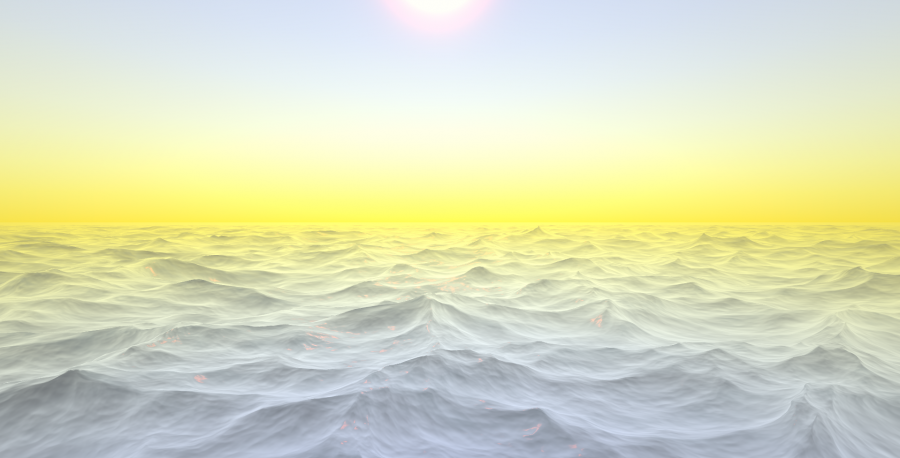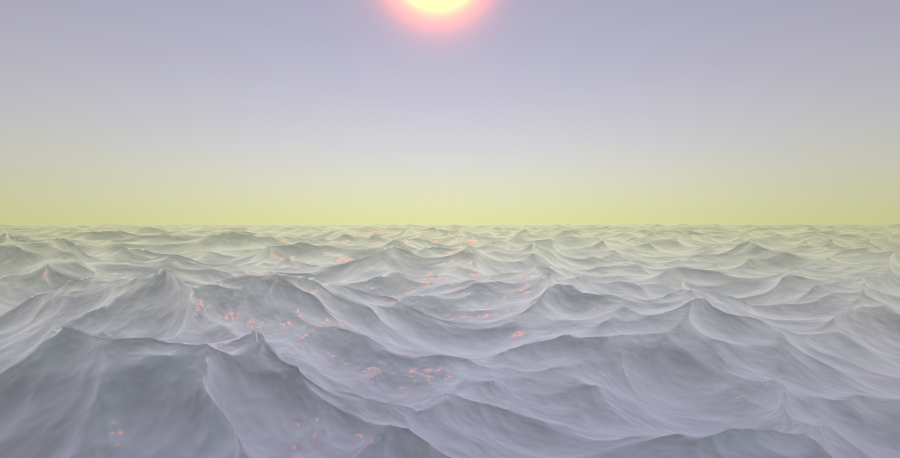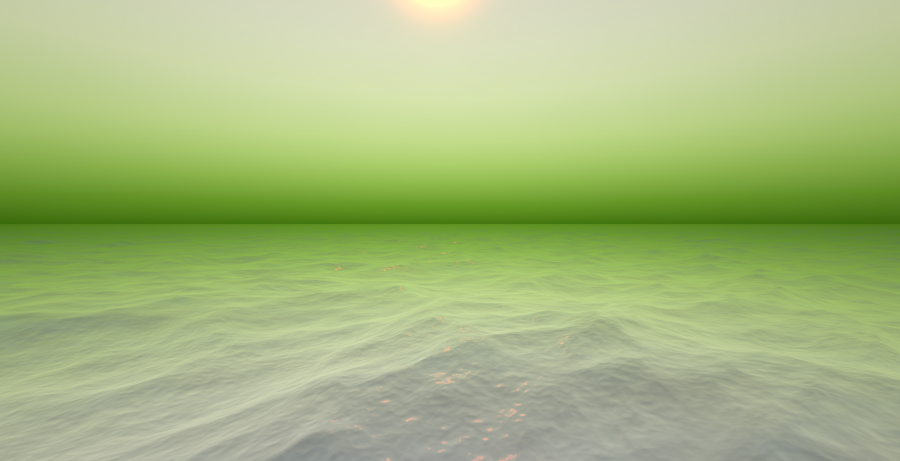
Interview with Yuri Pattison – Part One
The Douglas Hyde Gallery [online]
30 April 2020 – 13 May 2020
Interview by Aidan Kelly Murphy
Spring 2020 was due to see the opening of ‘The Engine’, Yuri Pattison’s new exhibition in Dublin’s Douglas Hyde Gallery and his first solo show in a major institution in Ireland. However, lockdown saw the exhibition delayed and Pattison presented a cross-section of the proposed work via the online screening, ‘sunset provision’ – a work that sees the artist render a seascape in real-time via a game engine. This engine is fed with data from an environmental air quality monitor, which generates a more vibrant and spectacular scene the greater the volume of carbon dioxide and other pollutants is detected. Previous versions of this work saw all components (the monitor, screen and viewer) inhabit one space. In this online iteration, the monitor was located within the artist’s home/studio and the screen occupied the viewer’s browser.
In early May, I discussed this presentation with Pattison over the phone from our respective lockdowns in Dublin and London, and the developing COVID-19 pandemic as well as its influence on the interpretation of his work. With rising cases, that initial lockdown extended through the summer, resulting in Pattison’s show opening to the public in December, when we reconvened to continue our discussion.
The elongated timeframe and continuing impact of the global pandemic has resulted in two distinct conversations, which will be published as two distinct texts. Below is a transcript from the first of these from 22 May 2020.
Aidan Kelly Murphy: This is the third time that the phrase ‘sunset provision’ appears in your work, what draws you to this?
Yuri Pattison: ‘Sunset provision’ is a legal concept that I’ve been attracted to. It’s a framework that bakes in the scenario of an ending. It was an obscure piece of law that saw software and services being built on temporary ground. Now they have become increasingly important and prevalent in the fabric of the day-to-day as billions of people encounter and use these services.
I am also interested in the broader idea of this term. Everything we do is unsustainable, but trying to untether oneself from an unsustainable activity is pretty much impossible because you’re trapped in the inescapable mechanisms and systems of the modern world. ‘Sunset provision’ also relates to this idea of separation and distance from the natural world; we can make a base connection with the sun and sunsets outside of these controls.
In previous work, you’ve commented on the devices and mechanisms used to optimise time. Here we see devices that investigate the perception of these vibrant, almost garish sunsets as attractive, whilst also commenting on the instability of systems that use ‘sunset clauses’.
Works have existed under variations of this title before, but it became very prescient in highlighting the unsustainability of the current system and our activities, which are literally harmful to the point of being lethal. I became aware of this living in London, where the authorities consistently hide the fact it’s the city with the worst air quality in Europe. The uRad monitor, which was partly developed to avoid another Chernobyl, became a solution to other environmental cover-ups. The fact that this technology was an open, available source of data really interested me and that it could be deployed in a way which was not didactic, but poetic. The spectacular sunsets we now encounter are inherently artificial: sunlight filtered by manmade particulates. I am interested in the phenomenon of collective awe and wonder at these events. We seem distracted by their novelty.

Artist : Yuri Pattison, sunset provision (stills) (2020 ~ ) WebGL Game Engine, uRadmonitor A3, live data Digital Fabrication and Development: Tom Merrell & Rob Prouse.
Title : Wednesday, 13th May 2020 @ 09.09
Website : http://www.douglashydegallery.com/yuri-pattison-screening
Credit : Yuri Pattison
We can see more tangible and visible examples of sunset provision in the public sphere with the COVID regulations to stay-at-home set to expire on certain dates. Do you feel the impact of the work will be heightened in the current environment?
In recent times we’ve seen a growing awareness of time and time passing, as well as attempts to mitigate and plan for the unplannable. ‘Sunset provision’ interrogates this and the way in which many regulators are expecting something to come to an end based on expectation, on hope. Previously we haven’t seen legal clauses like this operating on a governmental level. They’ve been very tangible, now everything feels very intangible. For me, it’s made me think not just of our relationship with time but our relationship with reality and who shapes that consensus.
There is a parallel between the way the interpretation of this work has been shaped by online viewing and the shifting experience of people living and working remotely.
We were promised the democratisation of the world with digital technology, but what is very apparent is how undemocratic these things are. There is not enough discussion about this great promise of viewing artwork online and how democratic it will be, especially complex works that go beyond the standard in terms of single-channel video pieces. My thinking around these works, of which ‘sunset provision’ is a component, was that they would be democratic as they would be accessible to all within a public gallery. This presentation was definitely a compromise as I knew a portion of the audience wouldn’t be able to access it due to the system requirements needed to run the screening at home. So it was an experiment in that sense, a challenge to see what would be possible within the technology. I also knew that, depending on the user’s equipment, certain aesthetic elements would change. The screenshots and images that people were taking of the work and circulating online are totally unique because the atmospheric conditions are never exactly the same. I was thinking about this collective perception of time and marking of time, and sharing of our experience, and trying to find a way to integrate these ideas.

Artist : Yuri Pattison, sunset provision (stills) (2020 ~ ) WebGL Game Engine, uRadmonitor A3, live data Digital Fabrication and Development: Tom Merrell & Rob Prouse.
Title : Tuesday, 5th May 2020 @ 12.58
Website : http://www.douglashydegallery.com/yuri-pattison-screening
Credit : Yuri Pattison
Watching this at home, I’m reminded of the viewing booths you presented in ‘context, collapse’ (2017) and the viewing chair in ‘The Everywhere Studio’ (2017). Was this personal viewing platform something that was going to be in the original configuration?
The planned version was more infrastructural than those shows, with four monitors facing different directions (north, south, east, west) – the gallery space is perfectly aligned along these lines. The intention for the work was also somewhat different, looking at an expanded reality and commenting on lonely workspaces which are becoming prevalent – this idea of being together, but alone. Now we have this situation where people experience the work alone, but together online. I’ve encouraged people to set-up the work and leave it on their machine; it was meant to be something left running in another tab. I wanted to present something that would not require huge amounts of attention and could be viewed in a passive way. There have been these huge opportunities to read and look at art online, but when I come to them, I feel I don’t have the mental capacity or the bandwidth to watch them because of the great weight of this present moment. I wanted to create a scenario where ‘sunset provision’ could be viewed passively.
You’ve previously used the gallery as a co-habitable space for the viewer and the work. What other aspects have changed for this presentation?
Previously the hardware that captured the data, rendered the video and displayed it were all in one space – creating a very closed feedback loop with the viewer. This version very much acknowledges the current situation and creates more of a direct conversation with the viewer as the atmospheric monitor is in my home, recording my living conditions. It only shows the sunset/sunrise loop, night-time is completely removed. It’s dealing with the idea that as we push past the digital revolution, people are working totally untethered to their locale. People now work across borders, for instance in the UK, but on American time. We’re going to see much more of this as the ‘new normal’ continues.
Your sculptures in the past have contained so many breadcrumbs in terms of your influences and thinking. With this work, we see only the screen. How have you adapted to this?
Broaching the lack of materiality was a difficult aspect of it. Within my sculptural works I aim to give video and screen-based elements the same level of importance as the physical components, usually folding in and making visible the processes of digital production in the material presentation – providing breadcrumbs of extra information that provide links in and out of the show. With that said, there is always the possibility for embedded digital elements to circulate independently of these structures and for this body of work, at this particular time, I found it liberating for these generative scenes to travel, circulate and be viewed widely, despite the potential technical limitations and failures some might face when encountering the work from their homes.
***
Originally published by this is tomorrow, view online here.